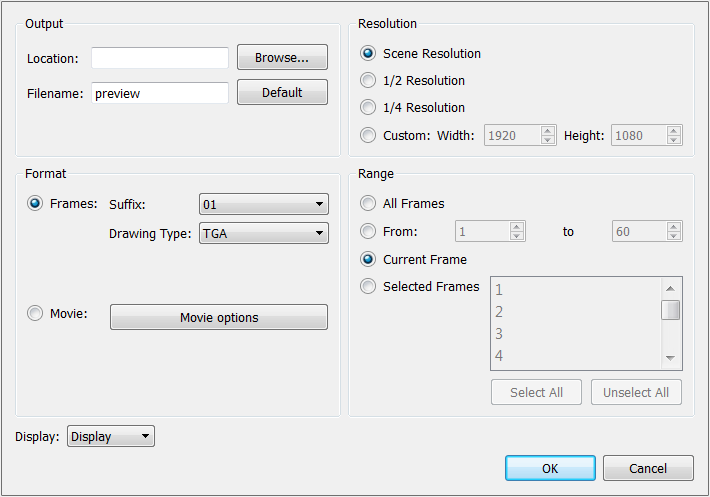Exporting OpenGL Frames
Use the Export OpenGL Frames dialog box to select the frames you want to render from the OpenGL Camera
view, then save the rendered frames as image files or as a QuickTime movie.
Frames saved from OpenGL view have neither anti-aliasing nor special effects. To render final frames with effects, export Images or a Movie.
To export OpenGL Frames:
|
1.
|
From the top menu, select File > Export > OpenGL Frames. |

|
2.
|
In the Output section, in the Location field, click Browse to select a folder for the frames. |
|
3.
|
In the Filename field, enter a name (prefix) for the frames or revert to the default name by clicking Default. |
|
4.
|
In the Format section, decide if you want to export individual image frames or a movie. |
|
‣
|
Suffix: From the drop-down list, select the desired suffix. If you intend to render only a few frames, you might decide to go with 1 or 01, whereas if you intend to render 1000 frames you might choose to select 0001. |
|
‣
|
Drawing Type: From the drop-down list, select the file type you want to render, such as TGA or SGI. |
|
•
|
Movie options: Click on this button to customize the Audio and Video settings for the *.mov export. |
|
6.
|
From the Resolution section, select the resolution you would like for your export. If you are running some quick tests, then you might want to cut down the resolution to save time and space. You also have the option to set a Custom width and height to produce smaller or larger frames. |
|
7.
|
In the Range section, decide whether you want to render all your frames, a range of frames, the current frame or selected frames. |
|
8.
|
Use the Display drop-down menu to select which Display module you want to use to render out your OpenGL frames from. It is always recommended to render out from the Display module, located under the final Composite module, unless you want to render out a specific section displayed by a particular Display module. |
Related Topics
